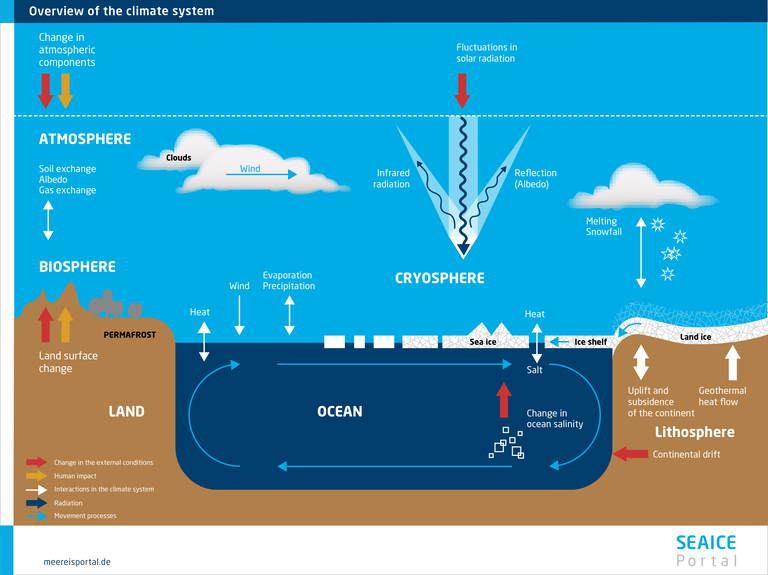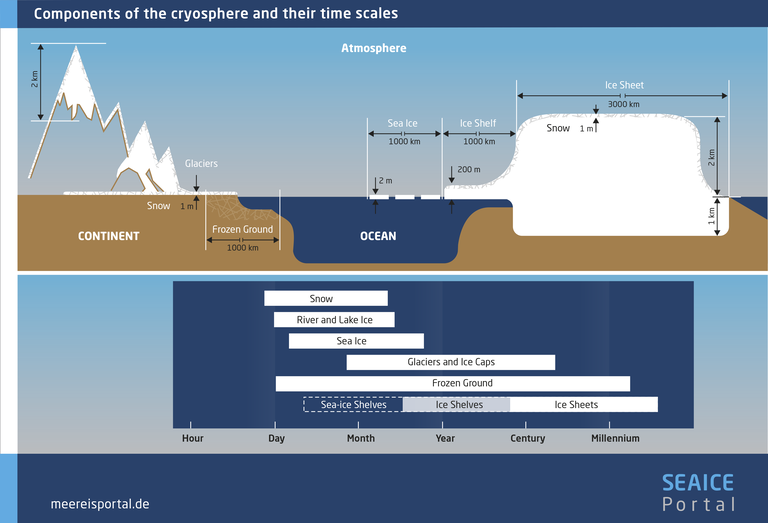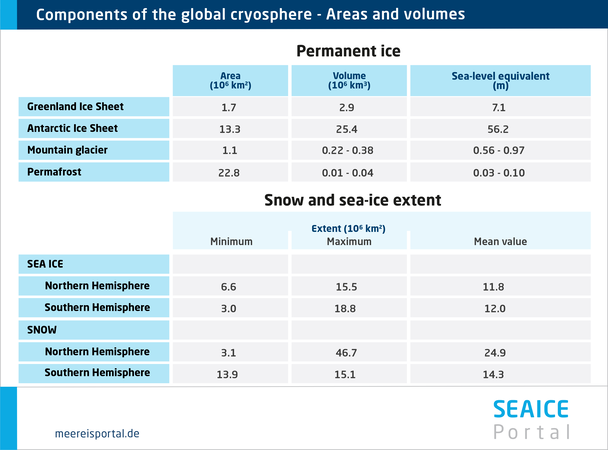Sea Ice Within the Cryosphere
Earth’s cryosphere encompasses all forms of snow and ice found on our planet: sea, shelf and inland ice, ice in permafrost soils, all snow-covered areas, and mountain glaciers. The word root “cryo” comes from Old Greek and means “ice” or “cold”. As such, taken literally, the cryosphere is the “cold region of the Earth”. In terms of its mass and heat capacity, the cryosphere represents the second-largest climate system component, after the ocean.
The Climate System
The climate system is defined on the basis of various components and includes the following subsystems:
- The atmosphere, with large- and small-scale processes like global wind systems and cloud formation; these processes can be dynamic, thermodynamic or chemical
- The hydrosphere (water shell), e.g. groundwater, rivers, lakes and seas, as well as processes like evaporation
- The cryosphere (ice shell of the Earth), e.g. mountain glaciers, the polar ice caps and sea ice, but also permafrost regions
- The lithosphere (stone shell), e.g. volcanoes or ores
- The anthroposphere, the habitat created by human beings. However, through their activities and due to the complex interactions in the climate system, human beings also affect all other spheres.
All components of the climate system are mutually influencing via complex causal mechanisms. These mechanisms follow the fundamental laws of physics – the transfer of energy (heat), momentum (Newton’s second law) and mass (evaporation, precipitation) – and can therefore be described scientifically.
The cryosphere of landmasses is home to ca. 75 percent of global freshwater reservoirs. Of these, the inland ice masses on Greenland and Antarctica easily make up the largest part – ca. 97 percent. The remaining three percent is spread about the ice-shelf regions of the Antarctic, Patagonia and Greenland, mountain glaciers and ice caps, seasonally frozen ground, permafrost soil, sea ice, and seasonally snow-covered regions of mountain ranges and the high latitudes. Smaller fields of ice and snow are numerous but only cover comparatively small patches of land. Roughly a quarter of the global surface lies atop permafrost. The seasonal snow cover is the most changeable variable in the cryosphere.
Principally speaking, the more mass an ice system has, the more slowly it changes. Whereas changes in snow and in river, lake and sea ice take only a few days to a few months, the ice in glaciers, inland ice caps and permafrost only changes over longer timeframes, from months to centuries – and for shelf ice (several centuries) and inland ice (tens of thousands of years), it takes even longer.
Accordingly, especially snow and river, lake and sea ice are relevant in connection with short-term climate variations. Conversely, long-term climatic changes in the course of centuries or millennia are above all influenced by permafrost and inland ice.


Climate Change (2007): The Physical Science Basis. Contribution of Working Group I to the Fourth Assessment Report of the Intergovernmental Panel on Climate Change [Solomon, S., D. Qin, M. Manning, Z. Chen, M. Marquis, K.B. Averyt, M. Tignor and H.L. Miller (eds.)]. Cambridge University Press, Cambridge, United Kingdom and New York, NY, USA, 2007, p. 341, graphic 4.1
Marshall S. (2012): The Cryosphere, Princeton University Press, 2012, p. 3

